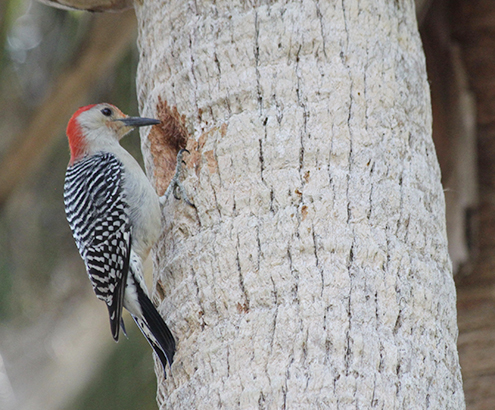
If you’ve ever heard a sharp drumming echo across your backyard or spotted a flash of red darting up a tree trunk, it was most likely one of Verandah’s most energetic birds—the red-bellied woodpecker. With its bold markings, curious nature, and unmistakable call, this striking woodpecker adds a lively rhythm to our neighborhood’s natural soundtrack. Whether clinging to trees or investigating new construction, the red-bellied woodpecker is a blend of beauty, brains, and behavior—and it’s right at home here in Verandah.
Red-bellied woodpeckers are medium-sized woodpeckers with black-and-white zebra-like striping on their backs and wings. Males have a full red crown and nape, while females wear red only on the back of the neck, with a paler head. Their long, chisel-like beaks are perfect for drilling into trees to search for insects, create nest cavities, or store food.
These birds are remarkably adaptable. While their primary diet includes beetles, ants, and other insects found under tree bark, they enjoy seeds, berries, and nuts. They are also known for “caching” food. They wedge acorns, seeds, and other morsels into tree bark or fence posts for later. This clever habit not only helps them survive during lean times but also aids in spreading seeds that grow into new plants.
Some Verandah residents have noticed woodpeckers tapping away at the foam trim on some homes or synthetic stucco. While this behavior can be frustrating, it’s not malicious. There are a few reasons for this: 1) Sound and Resonance – Woodpeckers drum on surfaces to communicate territory or attract mates. Foam trim or hollow surfaces can amplify their drumming, making it the perfect loudspeaker to announce their presence. 2) Mistaken Identity – Foam and synthetic stucco can mimic the texture of rotting wood, which often harbors insects. A curious woodpecker might peck to see if there’s a meal hiding underneath. 3) Exploration – These birds are naturally inquisitive. If a surface feels easy to peck, they may continue simply because they are curious.
While a persistent pecker can be a nuisance, these birds play an important role in controlling insect populations and creating nest cavities that other species, like bluebirds, later use.
Seeing a red-bellied woodpecker perched on a palm or oak tree is a reminder of the vibrant wildlife that thrives alongside us here in Verandah. With their bold colors, quirky habits, and loud calls, these birds bring life and character to our community.
10 INTERESTING FACTS ABOUT RED-BELLIED WOODPECKERS
1. Despite the name, their bellies are only faintly reddish—often hard to see. It’s the bright red crown and nape that really stand out, especially on males.
2. They don’t just peck for food—they also drum loudly on hollow trees (or even gutters and foam trim!) to mark territory and attract mates.
3. Their tongues are super long—up to 2 inches past the tip of the beak—and barbed at the end, perfect for snatching insects from deep crevices.
4. They are food hoarders! These clever birds stuff nuts, seeds, and insects into cracks in bark or fence posts to eat later.
5. Red-bellied woodpeckers have an excellent spatial memory and can remember hundreds of their hidden food stashes.
6. They are acrobatic climbers. Thanks to stiff tail feathers and zygodactyl feet (two toes forward, two back), they can scale tree trunks and branches with ease.
7. Besides insects, they eat fruits, acorns, peanuts, and even tree sap—making them one of the more omnivorous woodpecker species.
8. They often form long-term monogamous pair bonds and will defend their nesting territory together.
9. They have an eye for elevation. They often choose tall, dead trees or utility poles for nesting and drumming—places that offer a good lookout and sound effect.
10. Their rolling “churr” call is one of their trademarks—and both males and females use a variety of sounds to communicate warnings, mating interest, or territory disputes.





